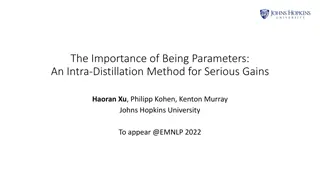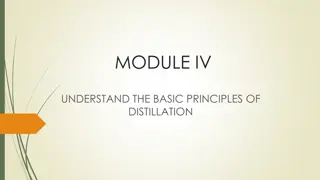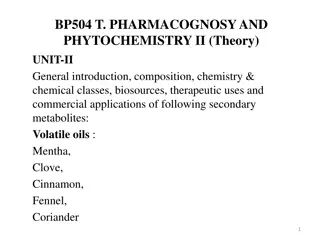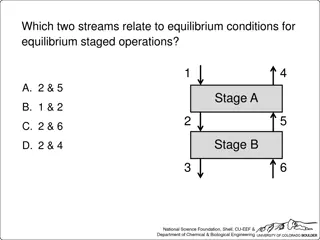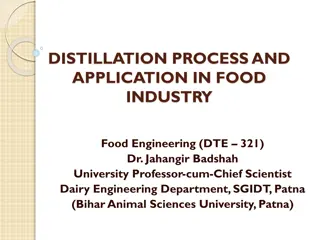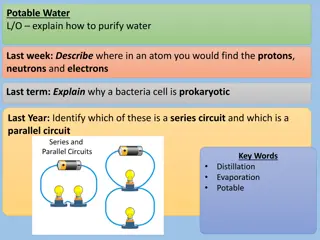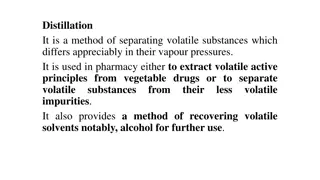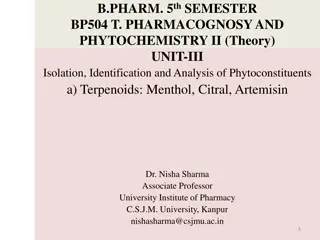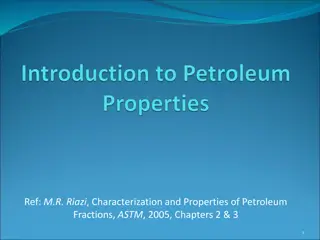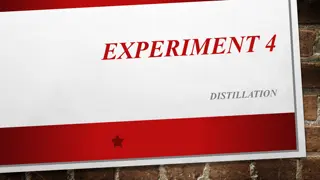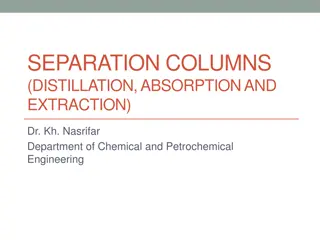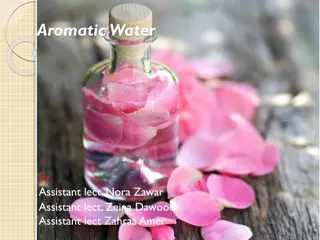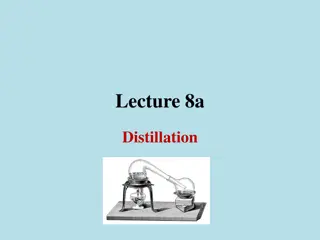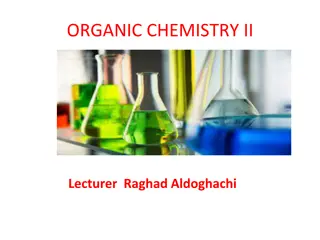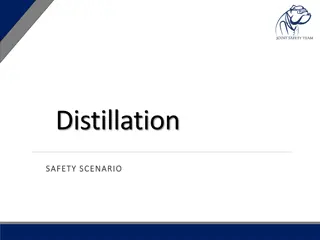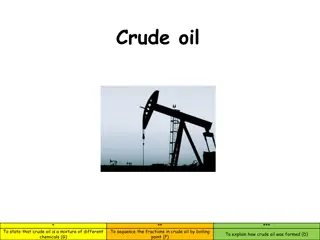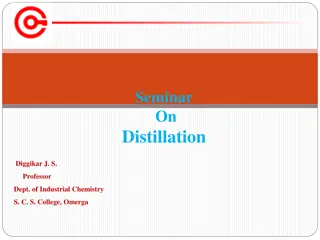Comprehensive Guide to Distillation: Types, Applications, and Advantages
Distillation is a widely-used method for separating mixtures based on differences in boiling points. This comprehensive guide covers the introduction, types of distillation, applications, advantages, disadvantages, and concluding remarks. Learn about simple distillation, fractional distillation, steam distillation, and more. Discover the uses, benefits, and drawbacks of distillation in various industries. Whether you're a student or professional, this guide provides valuable insights into the distillation process.
Download Presentation

Please find below an Image/Link to download the presentation.
The content on the website is provided AS IS for your information and personal use only. It may not be sold, licensed, or shared on other websites without obtaining consent from the author. Download presentation by click this link. If you encounter any issues during the download, it is possible that the publisher has removed the file from their server.
E N D
Presentation Transcript
www.studymafia.org Seminar On Distillation Submitted To: www.studymafia.org www.studymafia.org Submitted By:
Index Introduction Distillation Types of Distillation Applications of Distillation Uses of Distillation Advantages of Distillation Disadvantages of Distillation Conclusion
Introduction Introduction Distillation is a widely used method for separating mixtures based on differences in the conditions required to change the phase of components of the mixture. To separate a mixture of liquids, the liquid can be heated to force components, which have different boiling points, into the gas phase. The gas is then condensed back into liquid form and collected. Repeating the process on the collected liquid to improve the purity of the product is called double distillation. Although the term is most commonly applied to liquids, the reverse process can be used to separate gases by liquefying components using changes in temperature and/or pressure. A plant that performs distillation is called a distillery. The apparatus used to perform distillation is called a still.
Distillation Distillation Distillation is used to separate two liquids of sufficiently different boiling points. An equilibrium between vaporizing and condensing in a distillation column allows for the separation of liquids. Most of the lower boiling liquid is collected in a receiver vial while most of the higher boiling liquid remains in the original flask.
Types of Distillation Types of Distillation Some important types of distillation include: Simple distillation Fractional distillation Steam distillation Vacuum distillation Air-sensitive vacuum distillation Short path distillation Zone distillation
Simple Distillation Simple distillation involves heating the liquid mixture to the boiling point and immediately condensing the resulting vapors. This method is only effective for mixtures wherein the boiling points of the liquids are considerably different (a minimum difference of 25oC). The purity of the distillate (the purified liquid) is governed by Raoult s law.
Fractional Distillation Fractional distillation is often used to separate mixtures of liquids that have similar boiling points. It involves several vaporization-condensation steps (which takes place in a fractioning column). This process is also known as rectification. The apparatus required to perform a fractional distillation on a mixture is listed below. Round-bottom flask or distilling flask A source of heat, which can be a fire or a hot bath. Receiving flask to collect the condensed vapors Fractioning column Thermometer to measure the temperature in the distilling flask Condenser Standard Glassware.
When heated, the liquid mixture is converted into vapors that rise into the fractioning column. The vapors now cool and condense on the walls of the condenser. The hot vapors emanating from the distilling flask now heat the condensed vapor, creating new vapors. Many such vaporization-condensation cycles take place and the purity of the distillate improves with every cycle. An illustration depicting a fractional distillation setup is provided below.
Steam Distillation Steam Distillation Steam distillation is often used to separate heat-sensitive components in a mixture. This is done by passing steam through the mixture (which is slightly heated) to vaporize some of it. The process establishes a high heat-transfer rate without the need for high temperatures. The resulting vapor is condensed to afford the required distillate. The process of steam distillation is used to obtain essential oils and herbal distillates from several aromatic flowers/herbs.
Vacuum Distillation Vacuum Distillation Vacuum distillation is ideal for separating mixtures of liquids with very high boiling points. In order to boil these compounds, heating to high temperatures is an inefficient method. Therefore, the pressure of the surroundings is lowered instead. The lowering of the pressure enables the component to boil at lower temperatures. Once the vapor pressure of the component is equal to the surrounding pressure, it is converted into a vapor. These vapors are then condensed and collected as the distillate. The vacuum distillation method is also used to obtain high- purity samples of compounds that decompose at high temperatures.
Air-Sensitive Vacuum Distillation For compounds that are sensitive to air and readily react with it, the vacuum distillation process is carried out but the vacuum must be replaced with an inert gas once the process is complete. Such a process is often referred to as air-sensitive vacuum distillation. Short Path Distillation Short path distillation is used to purify a small quantity of a compound that is unstable at high temperatures. This is done under lowered pressure levels and generally involves the distillate traveling a very small distance before being collected (hence the name short path ). The reduced distance traveled by the distillate in this method also reduces the wastage along the walls of the apparatus.
APPLICATIONS OF DISTILLATION Distillation plays an important role in many water purification techniques. Many desalination plants incorporate this method in order to obtain drinking water from seawater. Distilled water has numerous applications, such as in lead-acid batteries and low-volume humidifiers. Many fermented products such as alcoholic beverages are purified with the help of this method. Many perfumes and food flavorings are obtained from herbs and plants via distillation. Oil stabilization is an important type of distillation that reduces the vapor pressure of the crude oil, enabling safe storage and transportation. Air can be separated into nitrogen, oxygen, and argon by employing the process of cryogenic distillation.
Uses of Distillation Uses of Distillation Distillation is used for many commercial processes, such as the production of gasoline, distilled water, xylene, alcohol, paraffin, kerosene, and many other liquids. Gas may be liquefied and separate. For example: nitrogen, oxygen, and argon are distilled from air.
Advantages of Distillation It is an efficient method of water softening for smaller purposes. It is relatively cheap. It can also be reused.
Disadvantages of Distillation As a process of water softening, distillation requires a keen eye, so that unwanted elements do not mix with water. When distillation is done on a larger scale, a very high amount of energy needed. The distilled water does not contain any oxygen and is also very tasteless. It has very high levels of acidity.
Conclusion Distillation should not be considered as a method of water softening because one might end up having unwanted elements in the distilled water. For example, liquids that have a boiling point equal to water will not be separated but will condense with the water. Moreover; the process requires a lot of energy to be carried out.
Reference Reference www.google.com www.wikipedia.com www.studymafia.org



